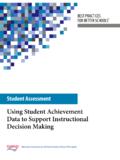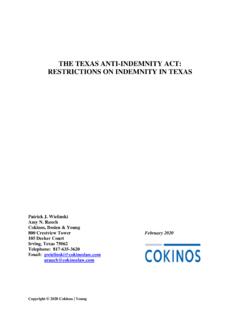Transcription of November/December 2008 The Evolution of Special ... - NAESP
1 1 2008 National Association of Elementary Principals. All Rights Reserved. T he events that have driven the gradual and progressive Evolution of Special education serve as a backdrop to understanding the foundation of the field and its ever-changing nature. Knowledge of this history is critical if we intend to make further progress. When Exclusion Was the Rule The philosophy of excluding students with disabilities from public school education can be traced back in legal history to 1893, when the Massachusetts Supreme court upheld the ex-pulsion of a student solely due to poor academic ability (Smith, 2004; Yell, Rogers, & Rogers, 1998).
2 Nearly 30 years later, the Wisconsin Supreme court denied education to a student with cerebral palsy because he produce[d] a depressing and nause-ating effect upon the teachers and school children (Smith, 2004). This is just one example of the widely accepted belief around the turn of the century that students with disabilities were best kept at the margins of society. The first significant court case to influence Special education actually addressed racial segregation. In Brown v. Board of Education (1954), it was determined that segregation on the basis of race violated equal educational opportunity.
3 The Brown decision led the way to a growing understanding that all people, regardless of race, gender, or disability, have a right to a public education. Opening Classroom Doors Although funding for Special education programs and training increased following Brown, school districts still had the right to choose whether or not to participate in Special education incen-tive programs throughout the mid-1960s (Smith, 2004). In 1965, with the passage of the Elementary and Secondary Edu-cation Act, schools began receiving federal monies for public education. A year later, an amendment to the act set aside funds specifically for students with disabilities (Yell, Drasgow, Brad-ley, & Justesen, 2004).
4 In 1973, Section 504 of the Rehabilitation Act stated that a person with a disability cannot be excluded or denied benefit from any program or activity receiving federal financial assis-tance, either public or private. The Americans with Disabilities Act of 1990 requires the additional compliance of school dis-tricts and institutions that do not receive federal aid. Defining Appropriate Education As late as 1975, up to half of the estimated 8 million children with disabilities in the were either being inappropriately educated or fully excluded from the public school setting (Pulliam & Van Patten, 2006).
5 Something had to be done to correct this situation, and the next major phase in the Evolution of Special education Evolution came on Nov. 29, 1975, when President Gerald Ford signed the Education for All Handi-capped Children Act, currently known as the Individuals with Disabilities Education Act (IDEA). What was previously seen as a privilege is now a legal right, and the basic requirements of the original law remain the hall-marks of Special education as we know it today: All children with disabilities must have an individualized education pro-gram (IEP), a free and appropriate public education, and be served in the least restrictive environment.
6 However, while the Education for All Handicapped Children Act focused on access to educational programs for students with disabilities, it did not address the degree of educational opportunity (Yell & Drasgow, 1999). Courts were left to decide what truly constitutes a free and appropriate public education in the least restrictive environment (Pulliam & Van Patten, 2006). The next major milestone came in 1982 with Board of Educa-tion of Hendrick Hudson Central School District v. Rowley, the first Special education case to land in the Supreme court . The court ruled that students who qualify for Special education services must have access to public school programs that meet their unique educational needs, and that the programs must be supported by services that enable students to benefit from in-struction (Yell et al.)
7 , 2004). The high court further ruled that while parents were not necessarily given the right to the best possible programs for their children, students with disabilities The Evolution of Special Education Kelli J. Esteves and Shaila Rao November/December 2008 Retracing legal milestones in American history. 2 2008 National Association of Elementary School Principals. All Rights Reserved. are entitled to an IEP reasonably calculated to facilitate learn-ing. The ruling gave lower courts a standard to follow when deciding what adds up to free and appropriate public education.
8 Providing Accountability According to the Department of Education (as cited in Yell & Shriner, 1997), by 1990 students who qualified for spe-cial education services had increased 23 percent since 1976, the year after the Education for All Handicapped Children Act took effect. At this time, amendments to IDEA provided supplemen-tal funding for state and local programming, mandated services for 3- to 5-year-olds, and added traumatic brain injury and au-tism to the existing disability categories. However, the 1990 amendments did little to address issues of low expectations for students with disabilities, the lack of focus on research-based programming, and the arduous paperwork tied to legal require-ments (Yell & Shriner, 1997).
9 Even though a growing number of students were receiving Special education services, only about 10 percent participated in statewide assess-ments (Thurlow, 2000), resulting in little account-ability for students with disabilities. Additional amendments to IDEA in 1997 shifted the focus from providing access to public education ser-vices to providing meaningful and measurable pro-grams for all students with disabilities (Hardman & Nagle, 2004). Significant components of the amend-ments were: The requirement that measurable annual goals be written; Mandatory assessment and measurement of progress; Increased parent involvement in the development of their child s IEP and an invitation to participate throughout the Special education process; and Mandatory reporting of goal progress to parents.
10 The law also stated that if a student was not making sufficient progress toward meeting IEP goals, the plan needed to be re-vised. In direct response to the growing inclusion movement, IDEA now required the IEP team to specify why a decision was made to pull a student with disabilities from the general education classroom (Yell et al., 2004). It also directed that a general edu-cation curriculum with supplementary aides and services must be considered before an alternative Special education curricu-lum is instituted (Yell & Shriner, 1997). Special Education Today More recent legislation, such as the No Child Left Behind (NCLB) Act and IDEA 2004, have enhanced the quality of Special education programs at the state level.
















